The engagement ceremony is an important ritual in Vietnamese wedding culture. Betrothal gifts are an indispensable part of the engagement ceremony, expressing the groom’s family’s reverence and respect for the bride’s family. Arranging betrothal gifts according to customs and traditions not only carries spiritual significance but also adds solemnity and beauty to the occasion.
This article will provide a detailed guide on how to arrange betrothal gifts for an engagement ceremony following traditional customs. Let’s explore together!
1 The Significance of the Engagement Ceremony and Betrothal Gifts
The engagement ceremony, also known as the betrothal ceremony, is an important ritual in Vietnamese wedding culture. It carries profound meanings, including:
Official Announcement of the Marriage Promise
This is the core significance of the engagement ceremony. After the groom’s family brings the gifts to the bride’s family, and the gifts are accepted, both families officially recognize the marriage between their children.
Expression of Gratitude and Respect
The betrothal gifts are a token of appreciation from the groom’s family to the bride’s family for raising their daughter. The exchange of gifts demonstrates the groom’s family’s respect and honor towards the bride’s family.
Commitment to a Shared Future
The engagement ceremony is a promise by both families to organize a wedding for their children. It is a commitment to a shared future for the couple, aiming for a happy and fulfilling married life.
 Significance of the Engagement Ceremony and Betrothal Gifts
Significance of the Engagement Ceremony and Betrothal Gifts
Bonding of the Two Families
The engagement ceremony is an opportunity for both families to meet, interact, and strengthen their bond. It serves as an important stepping stone for the two families to become in-laws, working together to foster the happiness of the couple.
Spiritual Significance
According to folk beliefs, the engagement ceremony also holds spiritual significance. The betrothal gifts are offered to the family ancestors to seek their blessings for the couple’s happiness and fulfillment in marriage.
Beyond these meanings, the engagement ceremony is a joyous occasion for both families to celebrate and share the happiness of their children’s big day. It is a beautiful memory that they will always cherish and treasure.
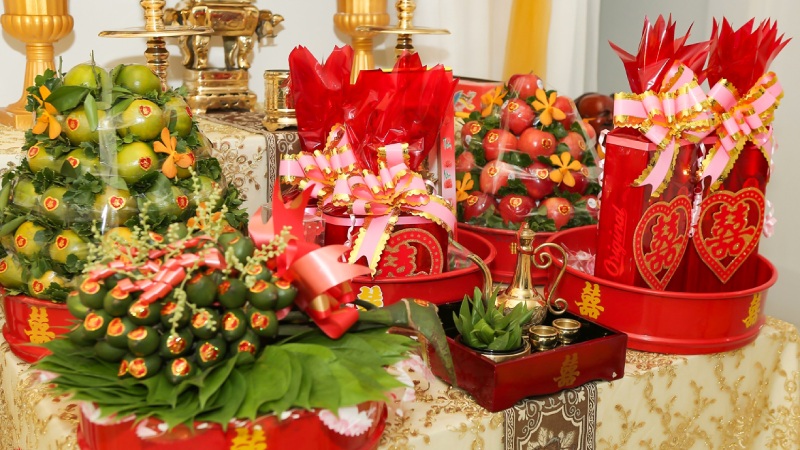 Spiritual Significance of the Engagement Ceremony
Spiritual Significance of the Engagement Ceremony
2 What are the Betrothal Gifts for an Engagement Ceremony?
The betrothal gifts for an engagement ceremony, also known as tráp ăn hỏi, are the trays of fruits and other items prepared by the groom’s family and brought to the bride’s family during the engagement ceremony. The number of trays and the contents of each tray may vary depending on regional customs and traditions. However, typically, the betrothal gifts for an engagement ceremony will include the following trays:
Betel and Areca Tray
This tray is an essential part of any engagement ceremony. The betel and areca tray usually includes a pair of betel and areca nuts, a bunch of areca nuts, a bunch of bananas, a pair of candles, a pack of cigarettes, and an envelope with small change. Betel and areca symbolize the strong bond between the two families, while bananas represent family reunion, candles symbolize light and good luck, and small change symbolizes wealth.
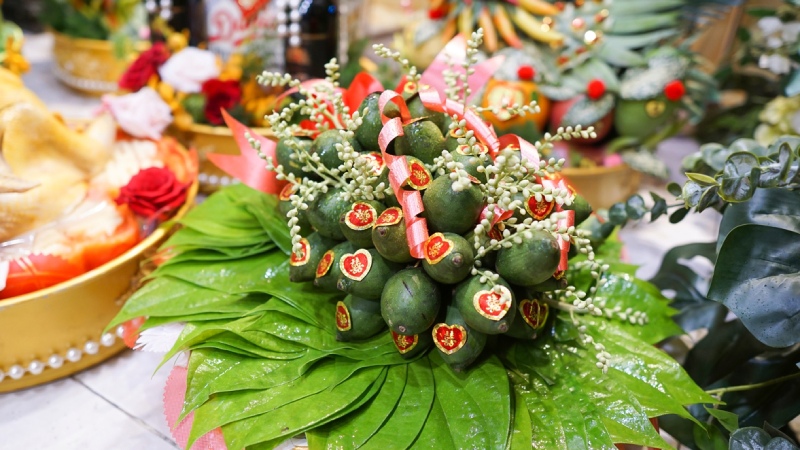 Betel and Areca Tray
Betel and Areca Tray
Tea and Wine Tray
The tea and wine tray typically includes a teapot, a bottle of wine, a box of tea, a box of cakes or candies, and an envelope with small change. Tea and wine symbolize the groom’s family’s respect for the bride’s family ancestors and their wish for a happy and fulfilling married life for the couple.
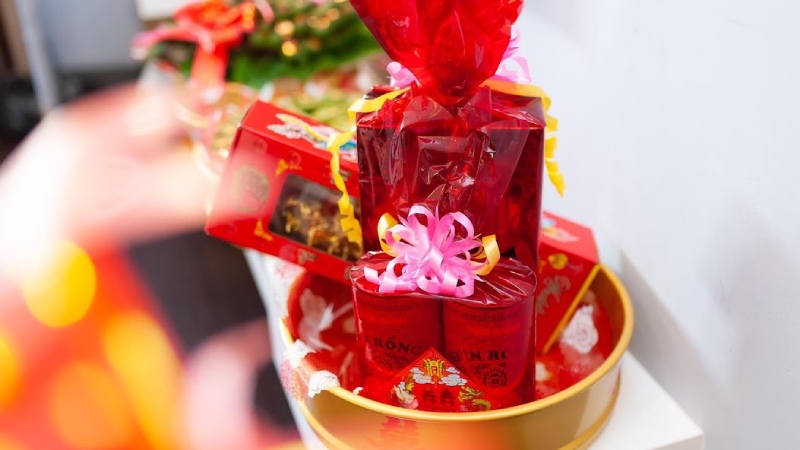 Tea and Wine Tray
Tea and Wine Tray
Cake Tray
The cake tray usually includes traditional cakes such as bánh phu thê, bánh cốm, bánh đậu xanh, bánh in, and bánh xu xê. Cakes symbolize the sweetness and fulfillment in married life.
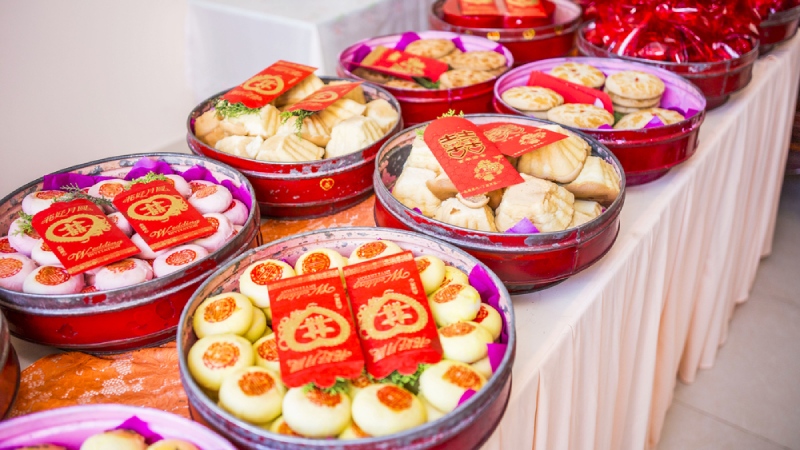 Cake Tray
Cake Tray
Fruit Tray
The fruit tray usually includes seasonal fruits, each carrying a specific meaning. For example, pomelo symbolizes good luck, watermelon represents children, papaya stands for prosperity, and dragon fruit signifies the unity of the dragon and phoenix.
 Fruit Tray
Fruit Tray
Red Sticky Rice Tray
The red sticky rice tray is usually offered to the bride’s family ancestors. Red sticky rice symbolizes good luck, prosperity, and happiness.
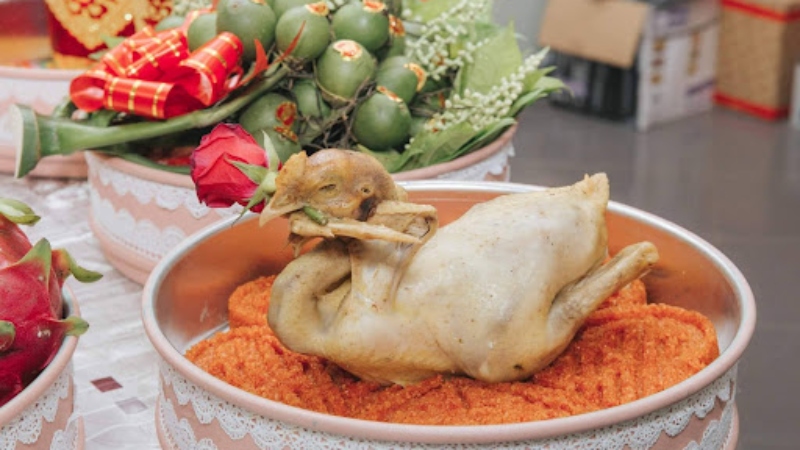 Red Sticky Rice Tray
Red Sticky Rice Tray
Roasted Pig or Chicken Tray
The roasted pig or chicken tray is the main dish of the engagement ceremony. It symbolizes abundance and prosperity.
 Roasted Pig or Chicken Tray
Roasted Pig or Chicken Tray
Black Money (Money for Wedding Expenses)
Black money is the amount of money given by the groom’s family to the bride’s family to cover wedding expenses. This money is usually divided into smaller amounts to purchase gifts, decorate the house, and cater to the wedding feast.
 Black Money
Black Money
Wedding Gold
Wedding gold is the amount of gold given by the groom’s family to the bride as her dowry. The amount of wedding gold can vary depending on the agreement between the two families.
Depending on the economic conditions and customs of each family, the betrothal gifts for the engagement ceremony can be prepared more simply or elaborately.
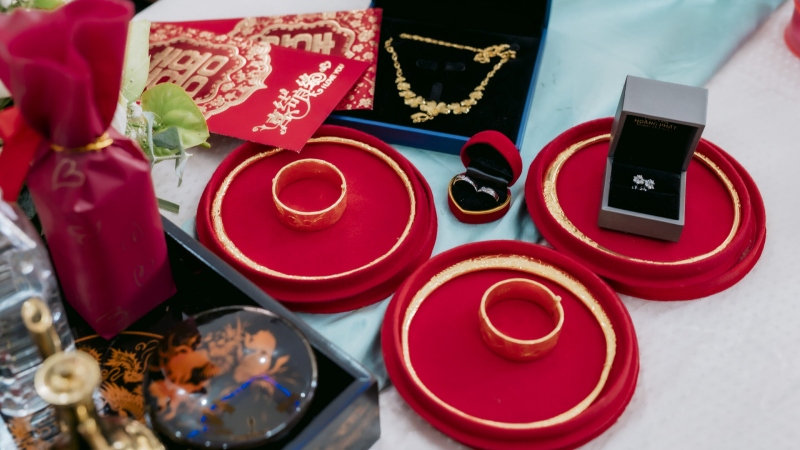 Wedding Gold
Wedding Gold
3 Some Notes on Betrothal Gifts for an Engagement Ceremony
- The number of trays in the betrothal gifts should be an even or odd number depending on the region.
- The fruits in the fruit tray should be carefully selected, fresh, and visually appealing.
- The trays should be arranged aesthetically and decorated respectfully.
- When presenting the betrothal gifts, the groom’s family should maintain a polite and respectful attitude towards the bride’s family.
Here are some suggestions for the number of trays in the betrothal gifts according to different regions:
- Northern Customs: 3, 5, 7, 9, or 11 trays.
- Southern Customs: 4, 6, 8, or 10 trays.
- Central Customs: 5, 7, 9, or 11 trays.
 Notes on Betrothal Gifts
Notes on Betrothal Gifts
It is advisable to consult with elders or experienced individuals in organizing weddings to prepare betrothal gifts that align with local customs and the family’s economic conditions.
The above information provides a comprehensive guide on betrothal gifts for an engagement ceremony. We hope these tips will help you prepare a thoughtful and meaningful engagement ceremony. Wishing you a happy married life!

































